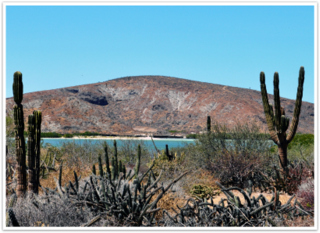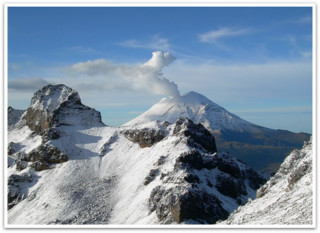
CLIMATE & WHEN TO VISIT MÉXICO
Find out here, when it´s best to travel to México
Mexico is one of the most geographically and climactically diverse countries on the American continent and each region is unique. It can sometimes feel as if you are traveling through different worlds, each one fascinating in its own way.
The numerous climate changes noted across México are due to the differences in latitude and longitude as well as altitude. If you are travelling between different climate zones in Mexico be prepared for humidity and heat as well as rain and cold weather, especially in the winter time.
CLIMATE ZONES IN MEXICO
Mexico is divided into four climatic zones according to altitude. These are referred to as “Tierra caliente” (hot zone), “Tierra templada” (temperate zone), “Tierra fría” (cold zone) und “Tierra helada” (ice zone).
Tierra Caliente – Hot Zone
The hot zone has a tropical climate which is characterized by high humidity and high temperatures throughout the year. This climate zone includes Mexico´s vast amount of coastal regions, the Yucatan Peninsula and the popular resorts of the Riviera Maya. In the winter months between November and February, it may be slightly cooler, but usually only at night and only if a cold front is coming in (frente frio). A light jacket or vest is enough as the temperature only drops slightly at night. The daytime temperatures are still quite comfortable.
Tierra Templada – Temperate Zone
The temperate zone is located at an altitude between 900 and 1800 meters above sea level. In this zone the days are pleasantly warm and the nights are characteristically cool. The average temperatures are between 17-21 ° C. The city of Cuernavaca is located in this zone and is also referred to as the “City of Eternal Spring” which is an excellent description of this climatic zone.
Tierra Fría – Cold Zone
The cold zone includes all of the destinations above 1800 meters, such as Mexico City and the Colonial Highlands. The average temperature is between 15 ° to 17 ° C and in the winter months it can get very cold at night. During the day between November and April it is almost always sunny and the climate is pleasant, but at night you have to dress quite warmly. If there is a cold front this region can easily cool to 0 °c at night.
Tierra Helada – Ice Zone
The ice zone includes all areas that are higher than 3000 meters above sea level and there is an average temperature of approximately 9 °c. At this level there are no populated villages or towns, but many hiking and trekking volcano tours are available. In the winter months temperatures can fall below zero and you should be equipped accordingly with warm functional clothing if you are thinking about participating in tours to this zone.
Rainy Season
Because of its proximity to the equator, in Mexico, especially in the southern region, the seasons are referred to as dry and rainy rather than the traditional 4 seasons found in other parts of the world. In Mexico the rainy season is late May to November, but the distribution of rainfall varies widely. In the Northern regions of Mexico where it is very hot and dry, there is very little to no rainfall in this period. In the Colonial Highlands and in the coastal areas it rains a little bit every day, but mostly in the afternoons and evenings.
On the Caribbean Coast and on the Pacific Coast strong thunderstorms and tropical storms between August and October are not uncommon. The entire country is often affected by heavy rains and this can occur up to the highlands. Most rain falls in Chiapas, the most southern and fertile state of Mexico.
Best time to travel to Mexico
Compared to Central European temperatures, the climate in México is always warm and the country can be visited all year round. However, depending on the travel route, there are ideal seasons for travelling.
Best time to travel in Mexico from North to South
Baja California
Even during the rainy season from May to October, there is hardly any rainfall and all year round it is hot and dry. It can get really hot in the summer months, although the heat can be endured very well due to the low humidity.
Copper Canyon
It hardly rains here either, but it can get very cold in winter and it often snows due to the high altitudes. The best time to travel to the Copper Canyon is between March and October if you want to escape the cold.
Colonial Highlands & México City
The region from Guadalajara to México City can comfortably be visited all year round because even during the rainy season from May to October / November it rains briefly but only heavily in the afternoons or evenings. In the summer months, temperatures can rise up to 40 ° C, but the heat is also relatively dry and can be endured very well. The Colonial Highlands are the most beautiful shortly after the rainy season from November on, because then the landscape is a lush green colour, the climate is very pleasant and it begins to bloom everywhere. In the winter you have to be prepared for cold nights, but during the day the sun is almost always shining and it is pleasantly warm.
Sierra Gorda & Huasteca Potosina
As rivers and waterfalls are the highlights of these regions, the best time to travel is the dry season from End of November until beginnings of May. If you travel during the rainy season, the landscape will be beautifully green, but rivers are raging and the water shimmers brown rather than blue.
Pacific Coast
The beaches from Oaxaca to Acapulco and from Ixtapa to Puerto Vallarta can be visited all year round without having to expect a lot of rain. There will be regular rainfall during the rainy season, but usually also only briefly and in the afternoons and evenings. In the summer months from May to September it is very hot and there is high humidity. The best time to travel here is from November to April, as the climate is dry and templated.
Chiapas & Tabasco
The state of Chiapas is probably the most diverse and falls into two different climate zones. Tuxtla Gutierrez and San Cristobal de las Casas are located at 2100 meters and therefore belong to the “Tierra fría” (see Colonial Highlands and Mexico City). The rest of the region has a tropical climate and is warm and humid all year round. Chiapas is the state with the most rainfall and rain must always be expected. From May to October it rains almost every day but mostly in the evenings, briefly and heavily. In the dry season, like in the Sierra Gorda and Huasteca Potosina, the rivers and waterfalls are not quite as beautiful as during the dry season. The best time to visit Chiapas is from November to April.
Campeche & Yucatan
In these two tropical states, the most rain falls between June and September and the temperatures are warm and humid all year round. Here, too, it usually only rains in the afternoon and the sun shines during the day. Mérida is considered the hottest city in Mexico and in summer the temperatures often rise to over 40 ° C during the day. The best time to travel if you want to escape the rain and extreme heat is from November to early March.
Caribbean Coast
On the pristine beaches along the Caribbean Coast in the state of Quintana Roo, it is hot all year round and most precipitation falls from June to October. As in the other tropical areas, the rains here are short and heavy and usually only take place in the afternoon or evening. The sun almost always shines during the day and the humidity is extremely high during these months. The Caribbean coast offers optimal climatic conditions from November until end of March, because during this time it hardly rains, the air humidity is relatively low and the temperatures are perfect for a relaxing beach holiday on the white sandy beaches.
Hurrican Season in México
The official hurricane season in México lasts from 1st of June until 30th of November but most of the tropical storms happen in September and October. The danger is just as much on the Pacific as on the Atlantic coast and the hotels and travel agencies in these areas have been well prepared for this type of natural disaster since Hurricane Wilma 2005. Fortunately, since Wilma, no strong hurricane has hit México and most tropical storms don’t develop into hurricanes. The possibility that the coasts of Mexico will be hit by a strong hurricane is so low that it is not necessary to plan your vacation accordingly. However, if you want to avoid the risk completely, we recommend planning your vacation between the end of November and June.
Your current travel weather for México








